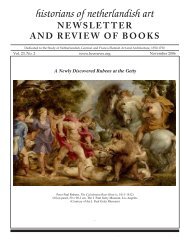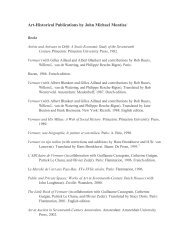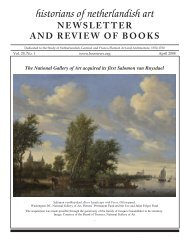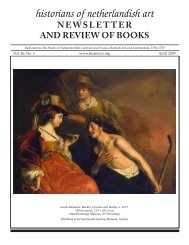newsletter - Historians of Netherlandish Art
newsletter - Historians of Netherlandish Art
newsletter - Historians of Netherlandish Art
Create successful ePaper yourself
Turn your PDF publications into a flip-book with our unique Google optimized e-Paper software.
Drebbel and Johann Rudolf Glauber, and physicians Paracelsus<br />
and Franciscus dele Boë Sylvius.<br />
<strong>Art</strong>ists, physicians, and artisans shared the goal <strong>of</strong> imitating,<br />
emulating, and manipulating nature. Accordingly,<br />
Smith’s narrative starts with the birth <strong>of</strong> painterly naturalism<br />
in fi fteenth-century Netherlands, recounting how Flemish<br />
artists proclaimed their ability to observe and carefully mirror<br />
nature and nature’s processes in their altarpieces, portraits,<br />
and books <strong>of</strong> hours. Landscapes, plants, animals and people<br />
were portrayed with increasing attention to detail, and naturalism<br />
also became a trend in the production <strong>of</strong> devotional and<br />
magical imagery. Smith recounts that a lifelike image <strong>of</strong> Christ<br />
on the cross did not simply represent Jesus more truthfully; for<br />
practitioners <strong>of</strong> magic it could also help summon angels and<br />
spirits more forcefully than a less exquisitely executed picture.<br />
Northern Renaissance artists were increasingly aware <strong>of</strong> their<br />
newly-gained authority over visual observation, and refl ected<br />
on their own achievements in their works <strong>of</strong> art. Mirrors within<br />
paintings, studies <strong>of</strong> St. Luke portraying the Virgin, and the<br />
genre <strong>of</strong> the self-portrait reveal how painters thought about<br />
their own pr<strong>of</strong>ession.<br />
The Body <strong>of</strong> the <strong>Art</strong>isan claims that artists and artisans imitated<br />
natura naturans, nurturing and productive nature in action.<br />
When creating lifelike images <strong>of</strong> nature, artisans followed<br />
nature’s own creative processes. The sixteenth-century ceramicist<br />
Bernard Palissy’s lifecasts <strong>of</strong> frogs, snakes and lizards were<br />
produced in a kiln by baking a mixture <strong>of</strong> clay and glazes in a<br />
mold – a mode <strong>of</strong> production analogous to how nature generated<br />
these animals through putrefaction in decaying soil. <strong>Art</strong><br />
and nature created life and competed with each other in the<br />
same process <strong>of</strong> heating up a mixture <strong>of</strong> soil, salts and ashes.<br />
In creating such lifecasts, the artisan’s bodily engagement with<br />
matter was exhausting and laborious, but resulted in a better<br />
understanding <strong>of</strong> nature’s own workings and secrets. Smith<br />
calls the knowledge accumulated in this way artisanal epistemology<br />
– a form <strong>of</strong> tacit knowledge (to use Michael Polányi’s term)<br />
<strong>of</strong> nature’s creative power acquired through bodily exertions,<br />
which cannot easily be reduced to theoretical statements. For<br />
Smith, this knowledge lay behind and established connections<br />
between the artistic success <strong>of</strong> the Northern Renaissance and<br />
the new philosophy <strong>of</strong> the scientifi c revolution, which relied<br />
on both observing and transforming nature. Moreover, in an<br />
explicitly Weberian twist, this worldly engagement with nature<br />
was also a novel method for artisans to commune with God<br />
and to seek redemption.<br />
In addition to establishing the importance <strong>of</strong> artisanal<br />
knowledge, The Body <strong>of</strong> the <strong>Art</strong>isan is also a social history <strong>of</strong> the<br />
arts and the sciences. Smith forcefully argues that fi fteenth- and<br />
sixteenth-century artisans carved out a new social identity and<br />
distinguished themselves from university-trained philosophers<br />
or the humanist culture <strong>of</strong> scholarship. The most vocal advocate<br />
<strong>of</strong> this new identity might well have been Paracelsus, who<br />
in the course <strong>of</strong> his itinerant career left no traditionally-minded<br />
scholar unscathed as he infl uenced a host <strong>of</strong> early modern<br />
surgeons and alchemists. According to Smith, even Dürer, an<br />
artist generally singled out for his humanist leanings, could be<br />
reinterpreted as an integral member <strong>of</strong> the artisanal culture <strong>of</strong><br />
his native Nuremberg.<br />
By the seventeenth century, the social status <strong>of</strong> the artisanal<br />
engagement with nature underwent a transformation.<br />
University-trained physicians, curious gentlemen, and philosophers<br />
joined artisans in proclaiming the primacy <strong>of</strong> new<br />
philosophy, ocular observation, and an experimental approach<br />
to natural knowledge, and they competed as interpreters <strong>of</strong><br />
nature. Painters and natural philosophers both agreed that<br />
knowledge could only be acquired through the senses, which<br />
were still prone to error and deception. While espousing artisanal<br />
knowledge, these new philosophers thus reasserted their<br />
superiority over artisans: nature revealed its secrets only to a<br />
modest, dispassionate and rational soul, embodied in neo-stoic,<br />
gentlemanly philosophers. Only such minds could control<br />
and overcome the potential failure <strong>of</strong> the senses. The artisans,<br />
whose senses were deemed to have been deceived by their<br />
bodily passions and commercial interests, were again excluded<br />
from dealing with natural knowledge.<br />
Smith’s argument is sweeping, bold, and convincing,<br />
encompassing three hundred years in just as many pages. Her<br />
cast <strong>of</strong> characters includes the most famous Northern painters<br />
and sculptors <strong>of</strong> the period, as well as lesser-known alchemists,<br />
medical practitioners, and even some extraordinary shoemakers,<br />
such as Hans Sachs and Jakob Böhme. These artisans were<br />
the product <strong>of</strong> the collective workshops <strong>of</strong> early modern crafts<br />
guilds, but they also transcended those origins by proclaiming<br />
their individual authorship and authority over nature. For<br />
Smith, these practitioners drove the scientifi c revolution, so<br />
she is less interested in extending her argument to reconsider<br />
the role <strong>of</strong> traditional heroes, such as Copernicus, Galileo, or<br />
Kepler.<br />
Since the publication <strong>of</strong> The Body <strong>of</strong> the <strong>Art</strong>isan, Smith has<br />
supplemented the book’s general argument with numerous<br />
case studies <strong>of</strong> alchemy and goldsmithing; additionally, historians<br />
<strong>of</strong> science Harold Cook and Lissa Roberts, for example,<br />
have discussed extensively how the growth <strong>of</strong> commerce fostered<br />
growing acceptance <strong>of</strong> experimental, material knowledge<br />
in the seventeenth century, and how artisanal epistemologies<br />
could interact with more theoretical study <strong>of</strong> nature. In sum,<br />
The Body <strong>of</strong> the <strong>Art</strong>isan is on its way <strong>of</strong> becoming a classic <strong>of</strong><br />
early modern studies, powerfully showing how the history <strong>of</strong><br />
science and art history should be studied together as part <strong>of</strong> a<br />
new disciplinary fi eld.<br />
Daniel Margocsy<br />
Dept <strong>of</strong> History<br />
Hunter College, CUNY<br />
Liesbeth M. Helmus, Schilderen in opdracht: Noord-<br />
Nederlandse contracten voor altaarstukken 1485-<br />
1570. Utrecht: Centraal Museum, 2010, 463 pp, 98 b&w<br />
illus. ISBN 978-90-5983-021-9.<br />
In recent years there has been a great upsurge <strong>of</strong> interest<br />
in the marketing <strong>of</strong> <strong>Netherlandish</strong> art. A critical resource<br />
for these studies is documentary information, especially that<br />
provided by contracts relating to the commissioning and selling<br />
<strong>of</strong> art works. Although these contracts <strong>of</strong>ten have a formulaic<br />
character, their specifi cations about issues such as scale, cost,<br />
delivery, quality, and iconography can <strong>of</strong>fer valuable insights<br />
into the processes <strong>of</strong> production and sale, as well as the nature<br />
<strong>of</strong> the relationship between buyer and artist. Helmus’s book is<br />
conceived as an examination <strong>of</strong> one body <strong>of</strong> contracts, those for<br />
North <strong>Netherlandish</strong> painted altarpieces from the late fi fteenth<br />
century through the late sixteenth century. These documents<br />
HNA Newsletter, Vol. 27, No. 2, November 2010<br />
21







